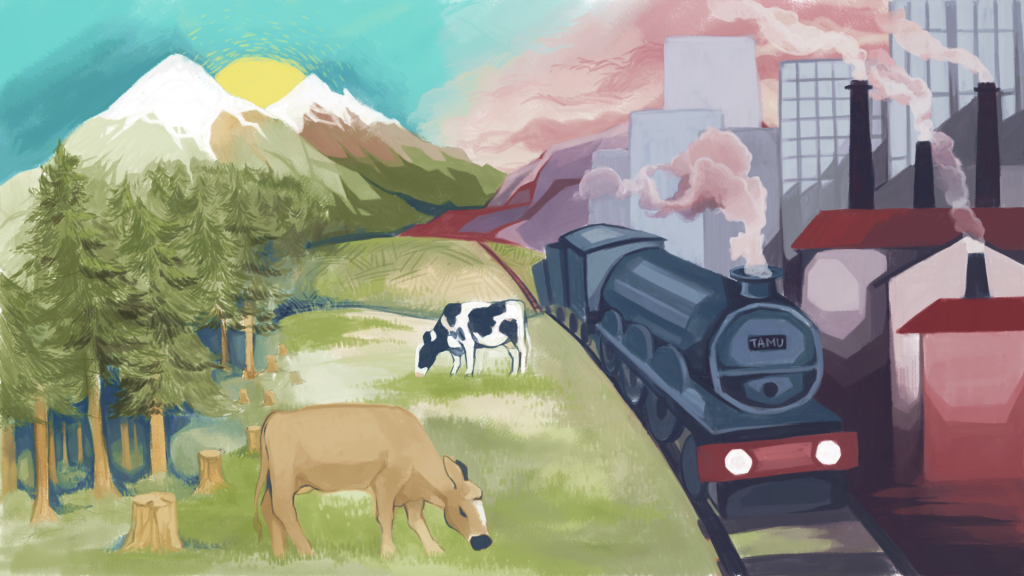How humans changed our world: New timeline shows when it started

From the time early humans made their first footprints on Earth to the detonation of the first atomic bomb, humans have made a lasting and permanent mark on the planet. A new paper from an international team of scientists that includes a Texas A&M University professor shows how humans have transformed the Earth and continue to do so.
Heather Thakar, assistant professor in the Department of Anthropology, is part of the team that had its work published in the current issue of Science magazine.
“Our team synthesized archaeological data provided by experts from around the world to establish a timeline for when people in different parts of the world began to intensify land use in different ways,” Thakar said.
The researchers looked at how human global land use has transformed the surface of the Earth, especially in the last 10,000 years. They divided Earth into 146 regions and used 10 time periods, from 10,000 years ago to 1850.
They found that about 42 percent of the regions examined had some form of agriculture by about 6,000 years ago, and that the beginnings of agriculture occurred earlier than previously believed.
By about 3,000 years ago, most of Earth had already been transformed by hunter-gatherers, farmers and pastoralists, the team said, and previous studies have underestimated the impact of early human land use on Earth’s current ecology.
“Think of it this way: when humans began to intensify land use in different ways, often times associated with increased food production, they also began to alter the local landscape and ecology in significant and lasting ways, such as human driven extinctions and deforestation,” Thakar said. “We have established that intensive human impacts on local environments begin much earlier than many researchers had previously assumed. This work provides important historical context for our rapidly accelerating impacts on the Earth.”
The team’s research also examines the origins of the Anthropocene, which is a term used to mark how people shaped the world and continue to shape it through their actions. The word combines “anthropo,” meaning human, and “cene,” meaning an epoch of geologic time.
“I would say the Anthropocene Era is already widely accepted by the scientific community,” Thakar said. “The idea that human activity has become a dominant influence on the global environment during recorded history is well-established. What is debated, across disciplines, is not whether the Anthropocene exists, but the point at which our actions as a species became a climatic-driving force on par with that of major geologic processes.”
She noted that the project contributes a global assessment of how far we can push scientific evidence of human-induced landscape transformations.
The Anthropocene includes major milestones in human history, among them the invention of the wheel 3,500 years ago; the printing revolution that began in 1439; the scientific revolution from 1543 to 1687; the invention of the steam engine in 1712; the world’s population reaching 1 billion in 1804; the first electric motor in 1822; the first modern oil well built in 1859; World War I and World War II; the atomic age in 1945; the “Great Accleration” of knowledge that began in 1950 and continued for the next 60 years with unprecedented discoveries; and to 2011 when the world population hit 7 billion.
It raises the question: what do the next thousand years hold for humankind?
“I think that we need to be concerned, not just about some distant future (1000 years), but the very near future (10-100 years) which offers our greatest opportunity to consciously, critically and deliberately influence the Earth’s climate,” Thakar said. “Our past does help predict our future, and our past documents humanity’s incredible capacity for innovation and collective action. Once we accept the truth of our role as climate-drivers, I believe that we will also find a way to ensure that our home remains habitable for our species.”
She added that archaeological data demonstrates humans’ ability to adapt to changing conditions, giving hope that we can find ways to adapt to global climatic changes in our future.
“But, what we face today is unprecedented in both pace and scope,” Thakar said. “We are at a critical turning point. In order to land safely in the future, we must change outdated and destructive habits and replace them with new, future-oriented solutions.”

